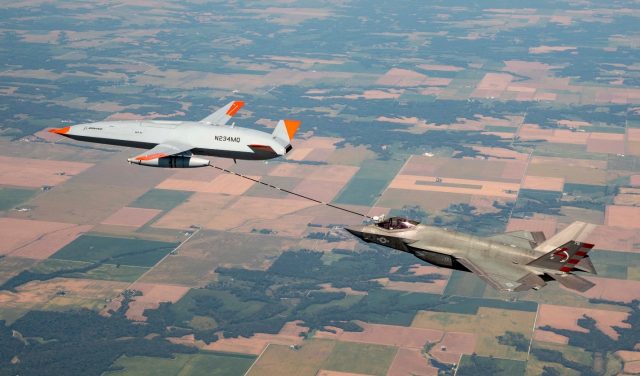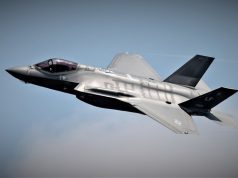
The US Navy’s Unmanned Carrier Aviation (PMA-268) program is continuing the testing campaign with the MQ-25 unmanned aerial refueling aircraft, completing the first ever aerial refueling maneuver with an F-35C Lightning II aircraft.
The integrated Navy and Boeing MQ-25 team, in coordination with the F-35 program, conducted the refueling flight on September 13 near MidAmerica St. Louis Airport in Mascoutah, Illinois.
“Every T1 flight with another type/model/series aircraft gets us one step closer to rapidly delivering a fully mission-capable MQ-25 to the fleet,” said Capt. Chad Reed, the Navy’s PMA-268 program manager. “Stingray’s unmatched refueling capability is going to increase the Navy’s power projection and provide operational flexibility to the carrier strike group commanders.”
This event marked the third refueling flight for the T1 test aircraft. During the three-hour flight, a Navy F-35C pilot from Air Test Wing and Evaluation Squadron Two Three (VX-23) approached T1, performed formation evaluations, wake surveys, drogue tracking and plugged with the MQ-25 test asset at 225 knots calibrated airspeed (KCAS) and altitude of 10,000 feet. From the ground control station, an air vehicle operator then initiated the fuel transfer from T1’s aerial refueling store to the F-35C.
Earlier this summer, the program completed unmanned refueling missions with an F/A-18 Super Hornet and E-2D Advanced Hawkeye. Each aircraft platform is aerodynamically unique so how they respond in the wake of a tanker is different. Flying different aircraft behind the MQ-25 lets us assess how they will interact, Reed said.
Once operational, MQ-25 will refuel every receiver-capable carrier-based aircraft. Each unique aircraft platform will have a different aerodynamic interaction in the wake of MQ-25. Conducting refueling test missions with various aircraft allows the program to analyze data and determine if any adjustments to guidance and control are required.
Following the latest flight, T1 will enter into a modification period to integrate the deck handling system in preparation for a shipboard demonstration this winter.
To date, T1 has conducted 36 flights, providing the program with valuable information on aerodynamics, propulsion, guidance and control in advance of the MQ-25 engineering and manufacturing development aircraft deliveries.
The MQ-25 will be the first operational carrier-based unmanned aircraft and will provide critical aerial refueling and intelligence, surveillance and reconnaissance capabilities to support the Air Wing of the Future – a mix of fourth and fifth-generation aircraft, manned and unmanned platforms, and netted sensors and weapons.
Along with organic tanking, the MQ-25 will pave the way for manned and unmanned teaming (MUM-T) of carrier-based aircraft that will extend the strike range and enhance maneuverability. As unmanned tanking capacity increases, the manned tanker requirement decreases, promoting additional service life and capacity available for manned strike-fighter missions.


























